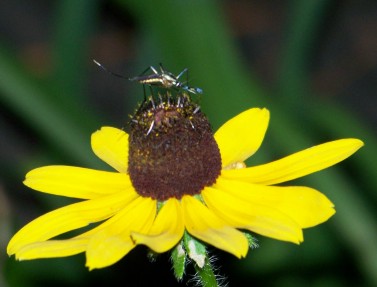|
Gardens Ablaze |
||
|
|
Insects &
Diseases
|
Personalized Engraved Garden Stones Custom engraved stones and rocks at SerenityHealth. Many sizes and fonts to choose from. |
|
Related Topics Site Map
Home
|
 Between
insects and weeds alone,
a homeowner can lose the battle for an attractive landscape in a big hurry,
and knowledge is the key to keeping both at bay. Insects and diseases can
weaken and kill plants, but good gardening habits and a keen eye can circumvent
most problems before they get out of hand. Don't automatically pull
out the chemical pesticides when you notice a problem in the landscape.
Instead, take the time to evaluate the problem and then take steps to solve
it safely and organically. If you have read any of the other pages
on this web site, it should be apparent that this entire site is devoted
to Organic Gardening
and solving problems without poisoning the environment. Between
insects and weeds alone,
a homeowner can lose the battle for an attractive landscape in a big hurry,
and knowledge is the key to keeping both at bay. Insects and diseases can
weaken and kill plants, but good gardening habits and a keen eye can circumvent
most problems before they get out of hand. Don't automatically pull
out the chemical pesticides when you notice a problem in the landscape.
Instead, take the time to evaluate the problem and then take steps to solve
it safely and organically. If you have read any of the other pages
on this web site, it should be apparent that this entire site is devoted
to Organic Gardening
and solving problems without poisoning the environment.
The first step when planning an attack on insects and diseases in the home landscape is to know your enemy. If you see damage on a plant, take the time to find out what is causing it. If it is a pest, you may not see the culprit right away. In some cases, as with Tomato Hornworms, you can simply pick the offending bug off the plant by hand and dispose of it. In other cases, you will have to plan a strategy and then carry out the plan. Look for symptoms of plant damage every time you survey your garden. The most common symptoms for insect and disease damage are listed below:
Insect Damage Disease Damage
-
Blistered or raised areas on the leaves Whatever the offending insect or disease, there are many ways to do battle with it without poisoning the landscape. Tactics include using insecticidal soaps, herb sprays such as garlic or hot pepper spray, traps, companion planting, and as a last resort, botanical poisons. Creating an environment conducive to beneficial insects and wildlife, with healthy well-worked soil is the ideal, however. Wildflower mixtures can be purchased that are packaged for the sole purpose of attracting beneficial insects to the garden. Other strategies for attracting these insects will be listed in the pages to come. This is a work in progress, so please Bookmark this site and return often, as these pages are updated daily. Meanwhile, feel free to browse the sections on Backyard Habitat and Companion Planting for further related information.
Custom Search
|
|
|
Gardens Ablaze |
||